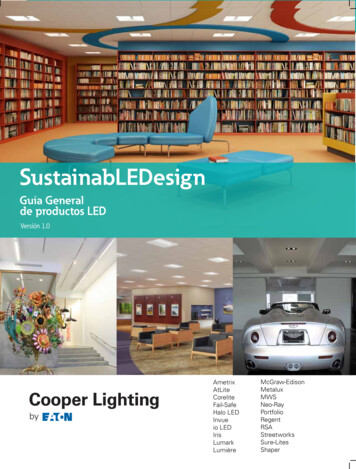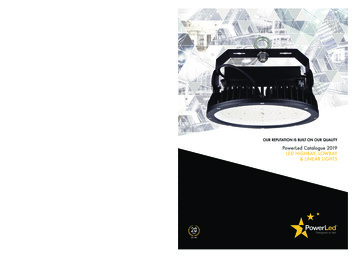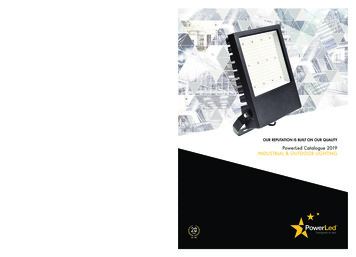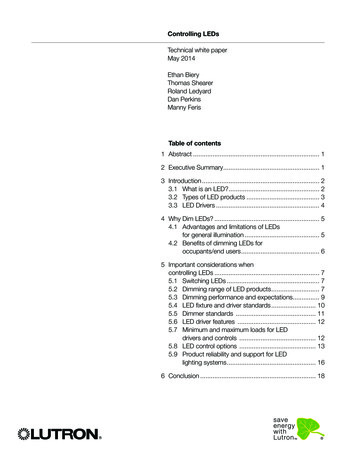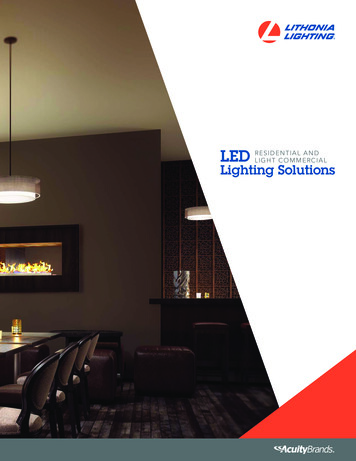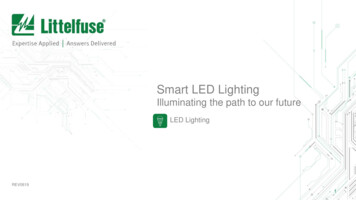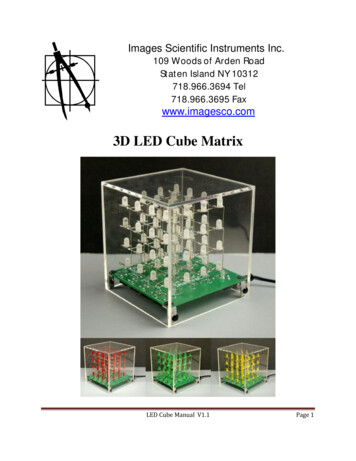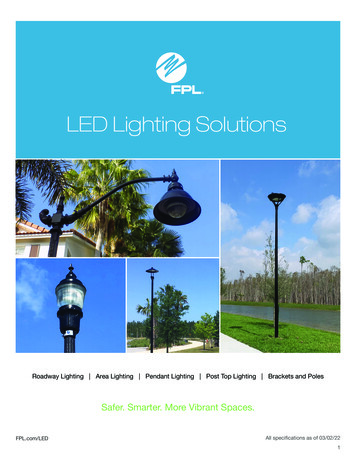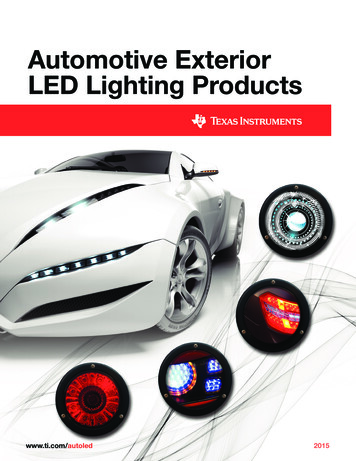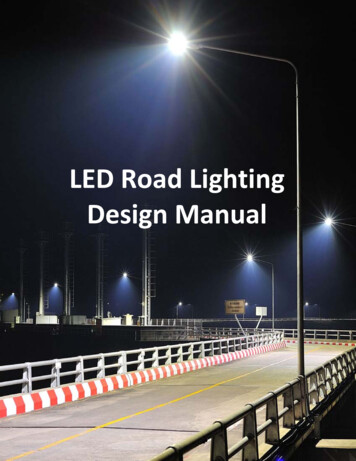
Transcription
oLED Road LightingDesign Manual
LED Road LightingDesign Manual
Copyright Information 2014 Development Finance International, Inc. This work may be reproduced and redistributed, in whole or inpart, without alteration and without prior written permission for non‐commercial use, provided that thepublisher is acknowledged and the work cited.Published 2014Printed in the Philippines.Prepared byCommissioned byAbout This Report: LED Road Lighting Design ManualThis manual is a vendor‐neutral knowledge management tool prepared by Development Finance International,Inc. and commissioned by Philips Lighting for professional reference by transport, urban, and energy sectorprofessionals.The information presented in this document does not form part of any quotation or contract, is believed to beaccurate and reliable, and may be changed without notice.No liability will be accepted by the publisher for any consequence of its use.Note: In this publication, ‘road lighting’ has been used to represent all lighting for roads, streets, walkwaysincluding in parks.All photographs are copyrighted by Royal Philips.Recommended Citation: Development Finance International, Inc. (DFI). LED Road Lighting Design Manual.Manila: DFI, 2014.
ContentsList of TablesiAbbreviationsiiWeights and MeasuresiiiExecutive SummaryivIntroduction1Features of an LED Road Lighting System3What are LEDs and LED Road Lighting Systems?3Features of a Solar LED Road Lighting System4Performance Comparison of LEDs and Conventional Technologies7Benefits of LED Road Lighting10Key Benefits of LED Road Lighting10Key Benefits of a Solar LED Road Lighting System14Implementing a Road Lighting Project16Challenges to LED Road Lighting Adoption21Cost Effectiveness and Financing22Cost Effectiveness of LED Road Lighting22Financing Options24Annex 1: LED Myths and Facts27Annex 2: Key Factors to Consider When Designing a Road Lighting Project30Annex 3: Success Stories36LED Road Lighting: Malaysia36Solar LED Road Lighting: China38Annex 4: Technical Specifications41Technical Specifications and Documents for LED Road Lighting Solutions42Technical Specifications and Documents for Solar LED Road Lighting Solutions45Sample Specifications51Glossary53References55
List of TablesTable 1: Comparison of Road Lighting Technologies8Table 2: TCO Calculation of a Retrofit Road Lighting Project22Table 3: TCO Calculation of a Greenfield Road Lighting Project23Table 4: Payback Calculations24Table 5: Los Angeles Street Lighting Project Statistics24Table 6. LED Equivalents of Typical HPSV Wattages29Table 7. Lighting Classes for Motorized Traffic34Table 8. Lighting Classes for Pedestrian and Low‐Speed Traffic Areas35Table 9: Lighting Performance Test Results for Nanyang Solar Road Lighting Project39Table 10: TCO Calculation for Nanyang Solar Road Lighting Project40i
MSRTCOTIUVAlternating currentBus rapid transitLos Angeles Bureau of Street LightingCommission International de L’eclairage (International Commission on Illumination)Correlated color temperatureColor rendering indexDepth of dischargeDirect currentElectromagnetic compatibilityElectromagnetic fieldsEnergy efficientEnergy service companyGreenhouse gasHigh pressure sodium vaporInternational Commission on Non‐Ionizing Radiation ProtectionInternational Energy AgencyInternational Electrotechnical CommissionIlluminating Engineering SocietyIngress protectionInternational Organization for StandardizationCity of Los AngelesLight emitting diodesMonitoring & evaluationMalaysia Ministry of WorksOccupational Health & Safety Advisory ServicesPublic‐private partnershipsPhotovoltaicRevealing powerStandard deviations of color matchingSurround ratioTotal cost of ownershipThreshold incrementUltravioletii
Weights and lowatt‐hourLumen outputLumens per square meterLumen per wattMetric tonMeter per secondPascalTerawatt‐hourVoltWattWatt‐peakWatt per square meter
Executive SummaryRoad lighting is an essential service provided by governments to ensure safety and security at night for driversand pedestrians alike. There is an increasing demand for this service from both rural and urban areas. However,rising energy costs, tight municipal and federal budgets, and rapid growth in overall electricity demand aremaking it an imperative for authorities to rethink how lighting can be provided in the most cost‐effectivemanner.Lighting accounts for around 19% of global electricity consumption. Most of it is concentrated in cities and urbanareas where road lighting can contribute up to 40% of the city’s annual electricity bill. Cities currently compriseof more than two‐thirds of the global energy consumption, with energy demand in cities expected to grow byalmost 60% by 2030.The urgency to replace old road lighting with more energy‐efficient (EE) technologies can no longer be ignored.This, coupled with the use of renewable energy sources, is essential to meet the expected increase in energydemand in an environmentally‐sustainable manner.Light emitting diodes (LEDs) are proven to be the most efficient option for road lighting today and can helpmunicipalities achieve up to 50 to 70% in energy savings over conventional road lighting technologies such asmercury vapor, metal halide, and high‐pressure/low‐pressure sodium lamps. There are now more examples ofLEDs being successfully adopted in pilot trials and large‐scale rollouts, delivering greenhouse gas (GHG)reductions by as much as 50 to 70% and generating significant budgetary savings that can be re‐invested inother public services such as education, healthcare, or infrastructure.The objective of this manual is to provide international funding organizations, client governments, and othersstakeholders a useful tool to integrate LED road lighting solutions into relevant Energy, Transport, Urban andRural Development projects. This manual suggests a practical project design and implementation roadmap thatintegrates industry best practices, internationally recognized standards, and cost effectiveness.The LED Road Lighting Design Manual addresses the following topics:Features of an LED Road Lighting SystemThis section defines LEDs, LED road lighting systems, and solar LED road lighting systems, as well as the maincomponents which comprise each system. This section also lists the various factors to consider when building anefficient and quality LED road lighting system, as well as the key parameters which differentiate LEDs fromconventional lighting technologies.Benefits of an LED Road Lighting SystemThis section highlights key technological, economic, and social benefits when implementing LED road lighting.Additional benefits brought about by solar LED road lighting, as compared to grid‐connected LED road lighting,are also discussed.Implementing a Road Lighting ProjectThis section guides project managers on choosing the most appropriate lighting solution for a road based ontype of lighting project to be undertaken, project objectives, and financial/ budgetary requirements. In addition,the section lists the most common questions that need to be addressed when designing the project, coveringiv
topics such as: technology to be used; required light levels; pole height, distance, and positioning; and smartcontrols.Challenges to LED Road Lighting AdoptionThis section enumerates the various challenges which currently hinder the scaling up of LED road lighting. Thesechallenges need to be addressed to enable mainstreaming of LED road lighting into all transport, urban and ruraldevelopment, and energy sector projects.Cost Effectiveness and FinancingThis section addresses the financial viability of LED road lighting projects. It makes a case for the costeffectiveness of LED road lighting projects as well as available financing options by laying out typical upfrontcosts of implementing an LED road lighting solution, the lifetime costing when considering the total cost ofownership (TCO), and some successful financing models that have been implemented in LED road lightingprojects.AnnexesThe Annexes provide more comprehensive information on the various topics covered in the manual, going intofurther detail on how to design, specify, and safeguard quality for LED and Solar LED Road Lighting projects, aswell as various case studies.voAnnex 1 lists and dispels common misperceptions about LED lighting.oAnnex 2 describes various key lighting factors to consider when designing a Road Lighting Project as wellas minimum standards that need to be met to ensure safe driving conditions.oAnnex 3 provides case studies about successful LED lighting projects, covering each case study’sbackground, challenges, solutions, performance and achieved benefits, and financing models applied.oAnnex 4 goes into further detail, providing (i) industry standards for technical specifications for a tender,(ii) a list of recommended documents for submission with tender bids to ensure quality, and (iii) samplespecifications from an actual tender.
IntroductionFuture economic growth and energy access need to be planned along a sustainable path that integratesenergy conservation and renewable energy use with traditional energy sources. Access to energy is essentialfor economic growth, especially in urban areas. As Asia, Africa, and Latin America continue to grow, the demandfor energy will increase exponentially, placing excessive pressure on finite resources and increasing energy costs.In addition, the use of fossil fuels adds to GHG emissions, which are already at unsustainable levels.Globally, we can significantly reduce GHG emissions by 670 MT annually and associated energy costs by 50‐70% following a switch to LED based efficient lighting.1 The International Energy Agency (IEA) estimates thatlighting accounts for 19% of global electricity consumption and about 1.9 billion tons of CO2 emissions annually.2A switch to LED lighting can help save an average 50% in energy costs, which results in global savings of 160billion in energy costs, 555 million tons of CO2, and 1.5 billion barrels of oil every year. This is the equivalent ofthe annual output of 530 medium sized power stations at 2TWh/year. Road lighting accounts for 4% of globaltotal lighting3 and up to 40% of a city’s annual electricity bill.4 Thus, it offers an opportunity for quick wins anddemonstrability that can lead others, especially private entities, to make the switch to efficient lighting.LEDs are the most EE option for road lighting today and can help municipalities achieve 50‐70% in energysavings over conventional road lighting technologies such as mercury vapor and high‐pressure/low‐pressuresodium lamps. In addition, the shift to LED based EE road lighting technologies would help reduce GHGemissions and generate significant budgetary savings that could be re‐invested in other public services such aseducation, healthcare, or infrastructure.EE Road Lighting is particularly relevant for Transport, Urban, and Rural Development sectors:Transport: The transport sector accounts for roughly 26% of global energy consumption,5 mainly fossil fuels,making it a priority sector in the sustainability agenda. EE road lighting, non‐motorized transport, mass transitsystems, and clean fuels are all effective ways of promoting sustainable transport. This manual focusesexclusively on benefits of EE road lighting and ways to incorporate and mainstream EE road lighting in existingand new roads, in cities and rural areas. LED technology, with solar power or otherwise, is stronglyrecommended for new roads and Bus Rapid Transit (BRT) systems. It is the most cost‐efficient technology whenproduct lifetime and energy costs are considered. Besides energy savings and sustainability, EE road lighting alsopromotes safety and other social benefits.Urban: Cities house roughly half the world’s population today and consume about 67% of the world’s energysupply, with energy demand in cities expected to grow by almost 60% by 2030.6 The lighting sector offers anopportunity to capture quick gains through a switch to LED lighting, starting with road lighting. In addition to thefinancial and environmental benefits, good quality road lighting promotes security, better aesthetics, efficientuse of road network, and reduces road‐related accidents. These benefits encourage tourism and extendedshopping hours or related outdoor activities at night, resulting in income generation for urban residents. Theseare substantial benefits and need to be factored in when considering LED road lighting.Rural Development: For rural communities with limited or no access to electricity, LED / solar LED road lightingcan make a significant impact. Using a fraction of the budget needed for grid extension and energy supplyexpansion, governments can provide LED outdoor lighting and bring light to previously unlit communities.Extended daylight hours in communal areas and properly lit roads enable business, health, education,community and employment‐related activities at night, promote social cohesion by bringing members of theLED ROAD LIGHTING DESIGN MANUAL1
community closer together, and make these areas safer at night. Several projects implemented over the lastfew years in diverse locations across both developed and developing countries demonstrate the longevity, lowmaintenance, and community benefits of LED outdoor lighting.As this manual will demonstrate, LED road lighting is a “low‐hanging fruit” that can help governments andmunicipalities significantly reduce their electricity bills, the energy demand‐supply gap, and environmentaldegradation, while promoting economic, social, and sustainable development. This manual will provide apractical guide to LED road lighting project design and implementation, and aims to serve as an impetus forgovernments and institutions to mainstream LED into their projects.2LED ROAD LIGHTING DESIGN MANUAL
Features of an LED Road Lighting SystemThis section explains the basics of LEDs, LED road lighting systems, and solar LED road lighting systems, as well asthe factors to consider when building an efficient and quality LED road lighting system.There are several lighting technologies that can be used for road lighting and other outdoor lighting needs, suchas for parks, public areas, or parking lots. Conventional lighting technologies include sodium vapor (high/lowpressure sodium), mercury vapor, metal halide, fluorescent tube lights, compact fluorescent lamps, andincandescent lights. The latest road lighting systems are based on LED technology.What are LEDs and LED Road Lighting Systems?The LED road lighting system is similar to conventional road lighting to the extent that the basic parts are thesame – both systems have the pole, cabling, and the luminaire which houses the light source. However, whileconventional lighting technologies include a single light source (the bulb), the luminaire of an LED road light unithouses several parts, starting with multiple LED chips arranged in an array, combined with optics, heatmanagement, and a driver – all enclosed in a high pressure die‐cast aluminum and glass cover. LEDs: LED lights are diodes that emit light, are digital, and are based on the same technology ascomputer chips. LEDs first appeared in the 1960s, emitting a low‐intensity red light and were used asindicator lights. Over the years, LEDs have evolved rapidly and are now available across the visible,ultraviolet, and infrared wavelengths with very high brightness and power. It has thus become possibleto use LEDs in various lighting applications, with illumination distances of 400 feet (150 meters) or more.Current LEDs are very robust when sourced from quality manufacturers, of which there are a number inbusiness today. High‐quality LEDs typically have good color consistency, high lumen efficacy, and canmaintain high lumen output over the LED’s lifetime. As a digital technology, it is possible to manipulatethe light colors and light levels across a continuum. Optics: Optics manages the distribution of light. Specially designed lens systems should have a uniqueinner and outer profile to allow maximum spacing between the poles and cover higher road widths.Optics should be arranged in multiple layers to ensure adequate luminance and illuminance uniformityin the unlikely event of individual LED failure.LED ROAD LIGHTING DESIGN MANUAL3
Bad Optics:Multiple Spot OpticsGood Optics:Multiple Layer Optic Thermal: LED sources generate heat via conduction, though not in the light produced. Heat dissipation,(i.e., removing heat from the LED source) is critical to lumen maintenance, light output, light color, lightquality, and lifetime since heat negatively affects these factors. Driver: The driver provides the right amount of current to the LEDs and is an important part of totalsystem reliability. Besides providing a stable flow of current, the driver is responsible for all intelligence,such as dimming and sensor interfacing. Luminaire: This houses all the components and is responsible for effective protection from dust andwater ingression, as well as heat management. Fixture: Mechanical components such as the pole and internal cables complete the fixture and connectthe luminaire to the underground cables supplying electricity.Features of a Solar LED Road Lighting SystemLED road lighting technology has progressed to include solar energy as an energy source. Solar LED road lightingsystems have additional components that are not required for grid‐connected LED road lighting systems. Inaddition to the pole, luminaire, and cables that make up a conventional LED road lighting unit, the solar unit4LED ROAD LIGHTING DESIGN MANUAL
comprises a system that collects, stores, and deploys solar energy. A complete solar LED lighting system consistsof five main components: Solar Photovoltaic (PV) Panel is the energy‐generating component responsible for harvestingenergy from the sun and converting it to a usableform of electricity. Battery is the energy storage and supplycomponent of the system; it converts storedchemical energy into electrical energy. Thebattery in a solar lighting system is typicallyrechargeable and designed to supply energy tothe lighting system for up to 3‐5 consecutive rainyor non‐sunny days. There are called “autonomydays,” defined as the number of days the batterycan support the lighting system withoutrecharging. Charge Controller is considered the “heart of thesystem.” It harvests the current to charge thebattery during the daytime and discharges thebattery during the night to power the LED moduleas efficiently as possible. It also regulates the flowof electric current to and from the battery andprevents over‐charging, over‐discharging, or over‐voltage, all of which may reduce batteryperformance or lifespan, and may pose a safetyrisk. Luminaire here is the same as in the grid‐connected LED lighting system. In a solar LED lighting system itis identified as the energy‐consuming component responsible for providing an adequate amount of light. Mechanical Components (poles, internal cables) support the whole system by connecting the PV panel,battery, controller, and luminaire altogether. In a solar LED lighting system, this component plays aneven more essential role in the overall reliability of the system.Having good quality components is not enough to ensure reliability of the system. In fact, precisely because theseparate components need to be configured and integrated into a single system, solar LED lighting requires asystem approach that looks at how the whole unit works optimally and not just the performance of eachindividual component. A solar LED lighting system is more than just the sum of its parts: it requires seamlesssystem integration and configuration to deliver the required functionality and performance.The key to a reliable and robust solar LED lighting system is to guarantee the quality of each component andto ensure their proper configuration and integration.LED ROAD LIGHTING DESIGN MANUAL5
LED ROAD LIGHTING DESIGN MANUAL6
Performance Comparison of LEDs and Conventional TechnologiesWhen comparing the quality of light across technologies as well as across different LED solutions, it is importantto understand the key lighting parameters that define quality road lighting. These are: Lumen output (Lm): Amount of light emitted by the light source. Lamp wattage (W): Amount of electricity required by the lamp to emit the lumen output. Luminous efficacy (Lm/W): Luminous or lumen efficacy measures the efficacy of the light source – anLED in the case of LED lighting system, and lamps in case of conventional technologies. It measures howmuch light is being emitted by the light source per unit of power and is expressed in lumen per watt ofelectricity used. System wattage (W): Amount of electricity required by the system to emit the lumen output. System efficacy (Lm/W): Luminaires include ballasts, drivers, heat management systems, optics, all ofwhich can diminish the original luminous efficacy of the light source. Since the road surface is being litup by the luminaire as a whole, system efficacy is a better metric to use than luminous efficacy whenmaking comparisons. Watts per square meter (W/m2): The amount of power required for each lighting appliance toilluminate a road surface to the required light level. For road lighting, this is the most appropriate wayto measure the efficiency of a light source, though lumen efficacy or lumen output are often consideredeasier to measure. Lifetime (hours): Lifetime of LEDs is measured differently than conventional lighting technologies,which reach end of life at the point when they stop producing light entirely. However, LEDs typically donot stop producing light completely, but depreciate or dim over time to a point where the lumen outputis insufficient to meet the required light levels. For LEDs, industry defines lifetime as the point when theLEDs lumen output reaches 70% of the original. Color Rendering Index (CRI): An index used to measure an artificial light’s ability to reproduce the colorsof an object, relative to the natural light source (the sun) with CRI of 100. Higher CRI means bettervisibility.The table on the next page compares the most popular road lighting technologies in use today across keyparameters. For this table, we have assumed a one kilometer stretch of an M2 road7 that needs to be lit up, withpoles in the center median. Based on industry best practices for lighting levels required to light one kilometerof road, we can expect the following:LED ROAD LIGHTING DESIGN MANUAL7
Table 1: Comparison of Road Lighting TechnologiesHigh Pressure Sodium Vapor(HPSV)High Pressure MercuryVapor30m33 150W180W30m33 250W300W100 Lm/W60 Lm/W80 Lm/W48 Lm/W0.8612k hours1.425k hours 1,532 3,938 6,563No 70Yes25Yes 60LEDDistance between PolesNumber of PolesInvestment ( )Lamp WattageSystem WattageLuminous EfficacySystem Efficacy2Watts per square meter (W/m )LifetimeAnnual Energy consumption(@ 0.15/kWh)Hazardous SubstancesColor Rendering Index (CRI)30m33 70W70W90‐130 Lm/W(rapidly improving)90‐130 Lm/W(rapidly improving)0.3350k hoursThe most important differences to note among the three technologies in the table above are the following: W/m2 and energy consumption costs: LEDs provide directional light, making them very efficient whenlighting up specific surfaces like roads, and thus bringing down the W/m2 values. In comparison,conventional lamps dissipate light in all directions, including where it is not needed. Hence, LEDs usemuch less electricity to provide the same lighting level on the road. This is reflected in the annual energyconsumption costs, for which LEDs have the lowest. Lifetime: LEDs also have the longest lifetime, and despite higher initial investment, LEDs tend to be themost cost‐effective lighting option in the long run. This is due to other cost savings incurred during itsoperational lifetime including maintenance, repair, replacement, and disposal costs. Hazardous substances: LED systems are safer for the environment as they do not contain hazardoussubstances (e.g., mercury) as defined in international norms and also last longer, thus converting themto trash fewer times.Not all LEDs are created equalLow‐quality lighting manufacturers often put out misleading claims, especially pairing high light levels with lowprices. To guide practitioners, the manual has provided a “Myths and Facts” section in Annex 1 to highlight someof the more prevalent ones. In addition, below are a few key guidelines practitioners should follow: 8Manufacturers claim a certain performance efficacy for their product. Make sure this takes into accountthe performance of the complete system application (including raw components and the fixture), ratherthan just that of the LED chips (e.g., for LED chips with a luminous efficacy of 130 lm/W, the wholeluminaire may only have an efficacy of 90 lm/W).LED ROAD LIGHTING DESIGN MANUAL
Be sure to choose upgradable, future‐proof luminaire designs, which allow new LED modules to replaceold ones, without dismantling the luminaire from the pole and with no change to the drivers or othercomponents of the luminaire. Manufacturers offer a variety of warranties. Make sure any warranty offered is comprehensive andcovers the entire LED application, not just individual components. If the chips are under warranty for tenyears, but the optics or heat management is faulty, the product will not function properly. Most high‐end manufacturers will offer a comprehensive warranty of around three years. A manufacturer with a reliable product will have test reports to back up all reliability and performanceclaims. Make sure these tests and documents are available. Otherwise, be skeptical of ambitiousperformance claims.LED ROAD LIGHTING DESIGN MANUAL9
Benefits of LED Road LightingKey Benefits of LED Road LightingLED road lighting solutions offers significant benefits and options which are not possible with conventionallighting. Some benefits hold true for all LED lighting applications, while others are specific to LED road lighting.Technological benefits: LEDs represent the next stage in the evolution of lighting technology, moving lightingsolutions from analog to digital technology. This is the trend seen across different electrical appliances; radio,telephone, television, and camera have made the switch to digital in the past few decades. The technicalbenefits offered by LEDs include: High lumen efficacy: Currently, commercially available luminaires from quality suppliers typically haveefficacy levels of 90‐100 lm/W. However, with the efficacy levels of LEDs rapidly evolving, it is alwaysrecommended to consult with reliable manufacturers or industry representatives for the latest efficacylevels. Directionality and Reduced Light Pollution: LEDs’ directionality contributes significantly to their energysaving potential. LEDs provide directional light, reducing light wastage and directing the light where it ismost needed. This can also prevent unwanted dispersion of light to residences, nearby areas, and thenight sky, thereby reducing light pollution.8The high lumen efficacy combined with directionality makes LEDs suitable for many energy‐savinglighting applications.10 Long lifespan: Laboratory testing and experience indicate that well‐produced LED systems last 50,000hours or more9, depending on usage. This compares favorably against the 5,000 to 15,000 hour lifetimeof most conventional lamps. Superior quality of light: LED lighting has a high CRI, which together with its white light, offersenhanced night time visibility, making the roads brighter and safer. Some initial research shows that LEDroad lamps achieve greater light penetration through fog.10LED ROAD LIGHTING DESIGN MANUAL
Comparison of LED (left) and HPSV (right) under rain and fog conditions: White light from LED produces less glarethan the yellow light of HPSV in rain and fog conditions. Extended controllability: LED lighting is a digital technology making dimming and similar controlfunctions possible and easy. LED users can make precise adjustments to brightness, monitor fixtureoperation from a centralized location, and optimize energy efficiency by altering light output as needed.In addition, while conventional lighting technologies have shorter useful lives when they are dimmed,the effect on LEDs is the opposite: LED life is extended when dimmed.11 Durability: LEDs are highly resistant to vibration and other mechanical stress making them suitable forroad lighting, especially on bridges, elevated highways, and where there may be risk of vandalism.12 Aesthetics: LED lighting applications can provide colors across the full spectrum13, and thus help inimproving aesthetics of outdoor spaces, bridges, roads and buildings. Some examples include theEmpire State Building in New York, USA; the Dragon Bridge in Da Nang, Vietnam; and the Baron Palace inCairo, Egypt.LED ROAD LIGHTING DESIGN MANUAL11
LED Improves Aesthetic Appeal of Famous Landmarks: Empire State Building in New York, USA (top‐left), Baron Palace in Cairo, Egypt(top‐right), and Dragon Bridge in Da Nang, Vietnam (bottom).Economic Benefits: The strongest argument for a switch to LED road lighting is economic. The direct and indirecteconomic benefits of LED lighting include:12 Lower lifetime cost: During its much longer lifetime of 50,000 hours (compared to 15,000 hours or lessfor an alternative conventional technology), the total cost of ownership (TCO) of an LED road lightingsystem is lower by 50% or more. The TCO of a road lighting system includes energy, lamp replacement,and labor and maintenance costs. Income generation: Effective road lighting helps extend light hours in cities as well as rural areas. Thisprom
Inc. and commissioned by Philips Lighting for professional reference by transport, urban, and energy sector professionals. . lighting accounts for 19% of global electricity consumption and about 1.9 billion tons of CO 2 emissions annually.2 A switch to LED lighting can help save an average

